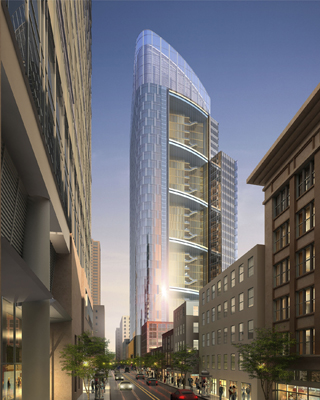|
Subscribe / Renew |
|
|
Contact Us |
|
| ► Subscribe to our Free Weekly Newsletter | |
| home | Welcome, sign in or click here to subscribe. | login |
Environment
| |
 |
February 23, 2012
Workers prefer their office makeovers green
Paladino and Co.

Pease
|
“You want to do what to my desk?”
Modifying the workplace can be one of the most stressful endeavors for an organization. Yet, change is necessary as the role of the workplace becomes more complex and companies must adopt new trends that attract and retain high-value talent.
Using sustainability as the common approach and business case for all workplace modifications can increase the rate of adoption and reduce drag during the process, both of which are killers to the bottom line. Research shows that 90 percent of people want to work for a company with a strong green reputation. Aligning to this desire can create a groundswell of support for new initiatives.
In addition, today’s knowledge worker is more connected and more flexible than any other generation on record. Cookie-cutter cubicles and crowded workstations are not only unappealing, they are now unnecessary when employees armed with a laptop and mobile phone can work almost anywhere.
The combination of these factors is leading companies to embrace both sustainability and mobility to support employees’ basic IT and operational needs while fostering engagement, driving down energy costs and responding to the desire of employees to work for a company aligned with their own values.
Flexible work spaces
If employees can work from anywhere, is it time to question the traditional solution of providing a dedicated workplace for every employee?
Plantronics, a headset manufacturer based in Santa Cruz, Calif., did just that. Its headquarters offers only unassigned desk space, and for only 60 to 70 percent of its employees. Thirty percent work offsite or from the company’s dedicated area at a coworking space in San Jose. Flexible spaces like “focus rooms” and team rooms accommodate a variety of work styles and project needs, while video screens and chat rooms allow team members to collaborate remotely.
Smaller, adaptable footprints like this have obvious environmental benefits — they require less resources to build and operate, and generate less landfill waste during renovation. However, a potential pitfall of smaller, closer quarters is disagreements about office temperatures.
No matter how good a building’s HVAC system is, 20 percent of the occupants will be either too cold or too hot, according to ASHRAE, a building technology group. Creating density will exacerbate this challenge as workers’ desks are downsized. This can lead to ad hoc solutions — a space heater under one desk, a fan on another — causing a push-pull that leads to higher energy use and dissatisfied employees.
There is a green solution to satisfy this group: different fixed-temperature zones throughout the floor plan. If 80 percent of the space is set to an average comfort level, 10 percent is slightly warmer and another 10 percent slightly cooler, combined with flexible configurations that allow employees to sit wherever they want, everyone can be comfortable and productive. Think about it — no employee complaints, more workers per square foot, and an energy-efficient building? The holy grail of operational success!
New technologies
There’s no question today’s technologies use less energy than yesterday’s, and the sooner they are put to use the sooner an organization can reap savings.
Roughly 30 percent of workplace energy used today is correlated to the office equipment. This equipment also produces heat, so you must spend extra cash to cool the space for workers sitting in front of a heat source.
The CPU under our desk consumes more power than a laptop, and laptops consume more power than tablets and smartphones. If power consumption is used as a key selection criterion, IT may find itself embracing solutions that appeal to mobile workers.
For instance, cloud computing moves applications and processing from local CPUs and puts it online. This not only saves space and enables easy access for remote workers, but associated energy and cooling loads disappear as well.
Data centers can run servers that are more efficient than hundreds of local computers, and they can run much warmer than an office space. Locate servers in West Texas with access to cheap renewable wind sources, and you quickly realize this IT trend can be extremely sustainable.
Old strategies
Many green trends focus on technology to solve the problem. Green workspace technologies such as underfloor air conditioning, automatic lights and photovoltaic panels sound great, but require upfront capital and can frustrate both busy operations staff that have to maintain it and occupants who can’t control it.
Sometimes it may be simpler to ignore some trends and hand controls to employees. Studies show access to operable windows correlates to acceptance of a wider band of temperatures, making natural ventilation a viable design strategy that can provide hundreds of hours of free cooling.
The Tower at PNC Plaza, a Pittsburgh high-rise under development by PNC Financial Services Group, will incorporate a double-walled envelope with operable surfaces on both exterior and interior window walls. An interior sliding door will allow employees access to the “porch,” enabling them to step out for fresh air whenever they want.
Vents and doors will close for extra insulation when the weather is not ideal. This combination will help the building run on a naturally ventilated cooling scheme for more than 40 percent of the year.
Employees can help
Organizations can capitalize on engaged, value-driven knowledge workers by creating opportunities for employees to participate in driving down energy use.
Lightweight and Wi-Fi-driven sensor technology means building owners have more controllability and more data than ever before, and can isolate power consumption down to a specific desk. By translating the data into real-world equivalents such as number of homes powered, employees immediately understand the impact of savings in a tangible way.
Once employees are aware of their energy use, actively engage them in developing strategies to reduce consumption. Some of the biggest savings can come from the simplest actions:
• If it has an off switch, use it. Turn off monitors when not in use and switch off the lights after leaving a conference room.
• Relax the dress code. Why spend extra money on cooling the space just to keep a suit on?
• Use the stairs instead of the elevator. Connecting energy management and employee well-being programs likely increases the adoption of both.
Simple signs and education programs, combined with ongoing reporting and celebration of successes, can make a group of employees one of the most powerful elements of energy efficiency in your building.
I recently encountered a sign at the entrance to the King County Chinook Building in downtown Seattle letting me know that if I elected to use the revolving door instead of the more convenient bypass door I would avoid 37 cents in utility costs. In today’s economic environment, this type of awareness program is a powerful motivator for behavior change.
Implementing changes in the workplace requires buy-in from employees, managers and building operation staff. Drag from any of the three groups slows the process down and can cost time, money and negatively impact engagement.
By using sustainability as the case for change, you’ll likely find those that were initially opposed to changing their work environment joining the bandwagon. The sustainability lens aligns these activities to the values of your workforce and creates a vision of the preferred future that everyone can support.
Brad Pease, senior green building consultant, leads the building science practice area at Paladino and Co., a sustainability and green building consulting firm.
Other Stories:
- Does a green retrofit make sense for your building?
- LEED platinum house: green from start to finish
- City expands its goals for green with 2030 District
- Which green certification program is right for you?
- 'Living buildings': What we’ve learned so far
- How we earned LEED platinum without blowing our budget
- ‘Living streets’ aren’t just for drivers
- Your projects can still be green, even if LEED doesn't fit
- Live, work and farm at Ballard's Greenfire
- Putting power-hungry data centers on a diet



